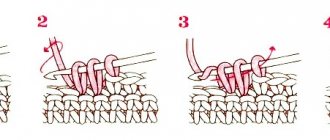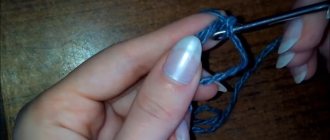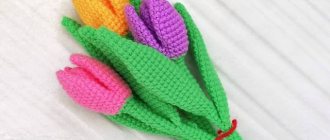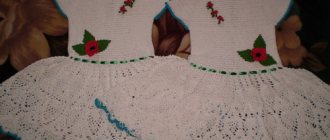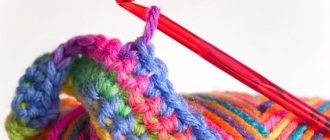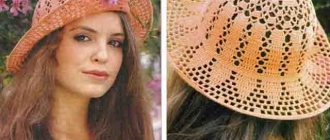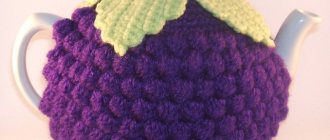Master class: crocheted openwork house boots
Knitted boots with a pineapple pattern consist of motifs of different sizes. They are lightweight and easy to use.
For work we will need:
- ballet shoes, which will serve as our basis;
- 200g blue ribbon yarn;
- hook No. 1.6;
- clear fabric glue
Description
To knit one boot, you need to make 2 motifs for the front part and position them in a mirror manner.
There are two halves for the sides, and one whole motif for the back. Next, we attach the pineapples to the leg to see where and how many we need to knit a dc or sc to fill all the gaps
For a better fit of the knitted part to the ballet shoe, you need to fold the last row in the toe area in half and knit a DC at the sides.
We tie the top and bottom parts with RLS, slightly tightening the bottom rows, as if fitting them under a ballet shoe.
If desired, knitted boots can be decorated with beads or seed beads. To ensure that the shoes fit well to the foot, use a caterpillar lace or just a chain of VP and 2 r. RLS.
How to make a pineapple pattern? We cast on 14 VP and then knit, as the diagram shows
Deciphering the circuits
Since shoes are most often crocheted, the basis is ordinary stitches, connecting ones, with one or two crochets. Schemes often come in conjunction with models; you just need to learn how to read them correctly. Abbreviations most often used in descriptions are the first letters: r. - row, st. b. n. – single crochet, in. p. - air loop, persons. – front, back. – purl, aux. - auxiliary, trace. - next. What to pay attention to when reading the diagram:
- knitting always starts from the first row;
- on the designation of loops, that is, columns;
- on decreases, which determine the fit of the leg;
- for increases, they are also capes;
- on arches made of loops, they are used in openwork.
Some of the symbols on the diagrams are very similar, it is important to be careful and not get confused. Experienced craftswomen recommend first trying to make a small piece of canvas, and then starting to create the entire product. If for some reason you can’t count the diagrams, the rows get confused, or difficulties arise with the description, then you can always look for video tutorials or turn to familiar needlewomen.
Master class: crocheted summer openwork boots
Beautiful summer boots with a fantasy pattern will be the perfect complement to an everyday sundress or evening dress.
To knit women's boots, you need to prepare:
- finished block;
- shoe glue;
- insoles;
- 200 g pink thread (100% cotton);
- hook No.2;
- decor
Description
We tie the insole 2p. RLS.
We knit the back part of the sole, where the heel is, with 10 rows of half crochets.
To knit a sock, select 10 in the center and knit 2 r. RLS and 10 r. Half-crochet with double crochet. At the same time, add 1 stitch on each side and knit 2 side loops. Then, up to the heel, we perform a fantasy pattern. Sew the junction of the toe and heel. Next, we knit 21 rows (in return rows, making lifting loops on the inside) with an openwork pattern to form the boot and finish with 2 rows. RLS.
Scheme of openwork (fantasy) pattern
We connect the knitted part of the boot to the last using shoe glue. The master class is over, the crocheted boots are ready.
Crocheted felt boots for babies made of multi-colored squares
Caring mothers can easily knit bright homemade boots for their child from leftover yarn. Multi-colored felt boots are knitted from the same motifs and according to the pattern they are combined into a single whole.
For work you will need hand materials: 5-6 skeins of wool yarn of the same thickness, hook No. 2.5-3 and a piece of leather or thick felt for the sole.
We knit squares according to pattern No. 1, changing colors and combinations of threads at our discretion. The number of squares depends on the leg, a child 7-9 years old is size 35 and 14 squares. When we begin to perform the 2-3-4 motif, according to scheme No. 2 we connect them with the previous details.
We place the baby’s foot on a piece of leather or felt and carefully trace it with a pen. We cut along the contour and make small holes around the entire perimeter so that the hook can fit through. We sew the finished felt boots to the sole, and feel free to try on a cute new thing on a joyful child.
We crochet women's ugg boots. Diagrams and description
UGGs are men's or women's shoes made from sheepskin so that the pile is on the inside and the smooth side is on the outside. Gradually, shoes that looked like short boots with thin soles and without heels received the name UGG. Let's look at a master class on how to crochet women's ugg boots.
To knit UGG boots:
- 250-300 g of beige wool blend yarn (you can use white threads if desired);
- hook No. 2.5-2.7 and 3.5;
- sole or insole
The finished shoes should be size 38-39.
Relief pattern - we knit each odd row with a sc, and each even row with a sc.
We start knitting ugg boots from the toe, which we make with a relief pattern.
We collect 5 VP at the beginning of the even row, then 2 VP lifting, at the beginning of the odd row - 1 VP lifting. Next we knit according to the pattern. Place a marker in the 10th row, on the increase side
To increase the ugg boots by one size, after the 17th row you need to knit 2 relief rows without increases, and then continue knitting according to the pattern, starting from the 18th row.
Next we knit the side part. On the first 10 pets. from the marker side we knit 33 rows with a relief pattern and finish the work with 1 r. SSN. The part needs to be sewn.
We perform the second toe of the ugg boots symmetrically.
On the side of the sole we tie 1 row of sc – 1 treble in the instep loop of the odd row and 2 trebles in the stitches. lifting an even row. You should get about 114 stitches.
From the side of the boot we tie 1 row of sc – 1 stitch per stitch. lifting each row. We get 45-46 loops.
Let's move on to knitting a puff.
Take hook No. 3.5 and knit in the round using 2 stitches. lift:
- 1r. – evenly add up to 60 dc;
- 2-4 r. – 60 SSN;
- 5 rub. – perform a uniform decrease up to 50 stitches;
- 6-7r. – RLS crochet number 2.7.
We knit rows 1-7 once, repeat 1-5, after which we change the hook to No. 2.7, knit 1 row of dc, 3 rows. Sc and return to hook No. 3.5. We knit 2 rows of sc and fasten the thread.
Ugg insoles (2 pcs)
We collect a chain of 8 VP, of which 2 lifting loops and knit according to the pattern of the SSN diagram. When moving from row to row, we knit 2 lifting loops together. If you need to increase the size of the insole, repeat row 7
We tie 1 p. RLS, and the side of each row is 2 RLS. In each loop of the first and last rows, 1 sc. Add 4 columns at the corners. You should get 114 stitches.
We find or cut out the sole of the desired size. Using an awl and thread, we connect it with a knitted insole.
We tie the edges of the RLS
We decorate the finished ugg boots. The shoes are ready.
Materials and tools
House slippers can be crocheted and knitted. It all depends on the skills of the craftswoman, the chosen model, and personal preferences. For outdoor products, a hook is more often used. The reason is the strength of the canvas. It deforms less, is not subject to stretching, it is easier to add the missing width or height of a part using a crochet hook, the columns can fit into almost any pattern, make additional binding, add some zest.
As for the size of the tool, it needs to be selected according to the yarn. Manufacturers usually indicate the recommended range on the label. To prevent the fabric from stretching, we knit with a smaller number. You will also need the following tools:
- needle or awl;
- scissors;
- tape measure;
- cardboard, oilcloth or pattern paper.
Additionally, glue may be required, sometimes elastic bands, zippers, fasteners, decorative straps, and beads are needed. In many ways, the set of tools is related to the chosen model. The greatest attention is paid to yarn. It depends on it whether the boots will keep their shape, whether the summer sandals will not stretch, and whether the child’s slippers will not rub.
Household shoes can be knitted from different yarns. Acrylic is excellent because it does not cause allergies. For warm slippers, pure wool or mixed with synthetic fiber is used. For summer options, you can take cotton. Outdoor shoes are not made from pure acrylic, as the feet will sweat, and the material itself often has a synthetic squeak. The following types of yarn are suitable:
- cotton;
- silk;
- linen;
- knitwear
Cotton with acrylic “Jeans” from the Turkish manufacturer YarnArt is especially popular among knitters. It has many analogues. This composition is durable, pleasant to the touch, does not cause allergies, does not irritate the skin, and does not rub. The price is also good. For summer sandals and sandals with ties, you can use stretch yarn. It will fit tightly around your leg. When making knitted shoes, you can mix several materials: linen or cotton for the main parts, elastic threads or elastic bands for fastening ties and straps.
Knitting needles
Types of hooks Cotton Silk
Linen
Knitwear
Wool Additional accessories
Master class crochet boots made from hexagons
We knit motifs in the form of hexagons according to patterns, starting with a chain of 3-6 VPs. Most often, several colors of yarn are used in the manufacture of one element. The size of each of the hexagons is calculated in advance, based on the size of the foot and the number of elements in the boots. For example, if a shoe consists of 6 motifs, then to determine its size we measure the length of the foot (the distance from the big toe to the heel), divide the result by 2 and add 1 cm. So, for a foot of 24 cm, the diagonal of the motif will be 24/2+ 1 = 13 cm
Hexagon knitting pattern
We knit the sole according to the diagram below:
The finished sole can be insulated and reinforced with felt and leather.
Let's move on to assembly. It is necessary to combine motives. This can be done in several ways:
1. Sew with thread;
2. Make connecting stitches without crochet
3. Knit an additional row of VP to connect the hexagons
4. Connect the elements tightly
We decorate finished crocheted boots to your liking.
Model selection
You can endlessly look through photographs of knitted shoes, look for interesting models, and choose a master class on making them. But there is one catch - the result does not always live up to expectations. Often, a handmade item brings only moral satisfaction and is not used in everyday life. You should immediately determine for yourself: are knitted boots needed, will a child wear such slippers, will a relative be happy with such an unusual gift? The main criteria when choosing a model: practicality, compliance with gender, age and preferences.
Children's
The very first knitted shoes for children are booties. To create warm models, pure wool or mixed yarn is used. It is important to make sure that the baby is not allergic to this material. Booties usually have ties or elastic bands to secure them on the foot. There are also summer or openwork socks. They are knitted from cotton, children's acrylic or semi-cotton, and have more of a decorative function. They are often decorated with beads, flowers, berries, and bows made of satin ribbons.
For children over two years old, you can make slippers, closed shoes, moccasins, and boots. Knitted sneakers with laces look interesting. This option is not only for boys, you can play with colors and decor. For a 5-6 year old girl, boots and shoes are an excellent choice. For home use, you can make shoes with felt soles. For walking outside, use the base from sandals and outdoor slippers. All products can be crocheted or knitted.
Booties Moccasins
Slippers Boots
Women's
You can never have too many shoes, you need them for all outfits, and even better - for every handbag or hat. Craftswomen have the opportunity to make any fantasies come true, as well as save the family budget. Having completed one or two models and understood the principle of creating shoes, you can come up with something of your own. For women they often knit:
- slippers;
- boots;
- shoes;
- ballet shoes.
Most often, women's models are crocheted, but you can knit shoes with knitting needles. In this option, it is important not to neglect the sample, wash it, dry it, calculate the number of loops in each centimeter and check whether the yarn stretches after wet-heat treatment.
Slippers Boots
Shoes Ballerinas
Men's
The most common, comfortable and popular knitted shoes for men are socks. Although, it makes more sense to call them footwear. You can knit from an elastic band or sock, crochet and knit, make a square, reinforced heel or boomerang. But the possibilities don't stop there. For a man you can knit:
- house slippers-galoshes;
- moccasins;
- flip-flops.
The original solution is unusual slippers in the form of a car or some kind of equipment. The most common designs are tank designs. A great idea for a gift for a man on February 23, for grandfather on Victory Day, or for any other holiday.
Socks
Slippers-galoshes
Moccasins
Flip-flops Tank slippers
Bright openwork boots for hot summer
Consider a master class on knitting beautiful boots with floral decorations
To work you need to prepare:
- 200g yellow yarn made of 100% cotton;
- leftover yarn of different colors for decoration;
- sole;
- hook No. 1.5 and No. 2.5.
We tie the sole with 1-2 rows of sc. Toe and heel we perform Dc. In the center, for a pointed nose, select 7 loops and knit a DC to the required height. At the same time, in each row on each side we add 1 DC, and on the sole itself we knit 3 loops together. We knit the heel without increments. If the boot does not fit tightly on the foot, then it is necessary to reduce the loops at ankle level.
We knit the boot, as shown in the diagram below.
Each flower is made according to the pattern
When the decor is ready, decorate the main product with it.
How to take measurements
When knitting shoes, knowing just your foot size is not enough, but that’s where you need to start. To take measurements, you need to stand on a white sheet with your feet in a standing position (this is important, since the parameters may change in a sitting position). Next, you need to draw four lines with a pencil: two to determine the length (perpendicular to the leg near the big toe and heel), the rest to determine the width (on the sides of the foot). It will also be necessary to measure parameters such as lift and fullness. For shoes and boots, you will additionally need ankle and calf circumference. What is important to pay attention to:
- on the width of the foot - taking this indicator into account, the sole is selected or manufactured;
- sandals, shoes must fit snugly to the foot, measured to the nearest millimeter;
- for house slippers you can add a loose fit;
- for children's shoes, 0.5 cm is added to the length.
Fullness of calves or ankles is not always needed, it all depends on the chosen model. For ordinary open slippers, socks, footwear, sometimes only the length of the foot and width are enough. If you are knitting openwork boots, which are usually spacious at the top, then you need to add 2-5 cm to the circumference of the shin for a loose fit.
Master class on the most beautiful high boots, crocheted
Do you have a pair of shoes that have lost their appearance? You don’t want to wear it anymore, but it’s a pity to throw it away? Then this master class is just for you. Let's give old shoes the right to a new, beautiful life.
What we need:
- a pair of old shoes;
- skein of yarn 50% cotton, 50% acrylic;
- hook No. 2.5;
- long needle;
- colorless glue;
- starch
So let's get started...
First we knit the overlays for the toe of the sandals using single crochets. We perform the decrease by applying knitting to the shoes. It is better to decrease 2 loops in the first row, and 1 loop in the subsequent rows.
Next we sew the sock to the shoe
It is more convenient to sew socks to shoes using a long needle in a circle. We hide the tails of the threads inside and carefully fill them with colorless glue
Now we knit and sew the backdrop. We make strips of the required length and width. We make the rounding point by knitting several stitches together
Using a long needle, we sew the heel to the shoe, tie the edges of the yarn into knots and hide them inside. Seal with colorless glue
Then we make the transition from the sock to the boot using single crochets
We connect the tongue with the central part with a chain of VP
We tie the resulting circle with several rows of sc and proceed to knitting the boot.
We make the top in circular rows using any fancy pattern. We knit the last 3 rows only with sc. We hide all the tails that will remain from cutting the yarn inside and fix them with glue.
Each master class showed us in detail how to crochet boots for indoors or outdoors. Also, you can turn old shoes that have become unusable into beautiful summer boots.
Advantages and disadvantages
Homemade slippers and booties have only one advantage: they warm your feet, knit quickly, and allow you to use a wide variety of yarns. Even from leftovers you can make something interesting and bright. There are an incredible number of models and schemes. Street types of products raise a big question. Many people still consider them impractical and requiring special care, and this is partly true. Street knitted models have certain disadvantages:
- Requires washing. Simply brushing off the dust with a rag or wiping the surface with a sponge will not work. Therefore, drying will also take time.
- They can stretch, which happens quite often. The shoes begin to dangle on the foot, and sometimes just fall off. Therefore, it is important to choose the right yarn, take a small size of knitting needles or hook so that the fabric is less deformed.
- Not always suitable for walking. Knitted fabric gets filled with dirt and loses its attractive appearance; walking along clearings or dusty streets in such shoes is definitely not worth it. But this is a great option for clubs, going to the cinema, theater and parties.
It is very important to choose the right sole. For street models, ready-made ones, for example, from old shoes, are suitable. For slippers that you plan to wear at home, the sole can be knitted from the thread used for the upper part of the product.
To wear knitted items not only indoors, but also outdoors, you need to think through all the details. It is necessary to take correct measurements and select materials. You can’t just knit sandals or boots from the first ball you come across.
Keeps your feet warm
Knit quickly
Allows you to use a wide variety of yarns Not always suitable for walking
Materials for home boots
To create house shoes, about 100 g of thread of the desired color, an awl and 2 insoles are used.
We recommend reading:
- How to knit a turban with knitting needles - 115 photos and videos of ideas, patterns and features of knitting a turban
- Knitting bags - 155 photos and videos on how to quickly knit a stylish bag with descriptions and diagrams
Knitting a jacket: 125 photos and video description of knitting with patterns for beginners and masters
Making holiday boots
First of all, the overlays necessary for the toes of the prepared shoes are knitted in single crochets. The base is made of air loops. The overlay is sewn to the shoes, the threads used are secured inside with glue so that they are not visible. The back surface of future boots is knitted in the same way as the toe.
The shin area is knitted in a circular pattern and the desired pattern is made. The last few rows must be done with single crochets.
Stages of work
Before crocheting house boots, you need to prepare all the tools and materials and think through the steps of making shoes. If there is not enough experience in this type of needlework, then first of all a simple model with a simple pattern is made.
Tips for beginners
Knitted shoes require experience and skill. It is better to practice making it on small models. For example, the first model could be house boots for a child.
The size of the hook is selected depending on the size of the thread. For openwork, lace summer boots, a thin thread and a hook size 2 are suitable. For warm shoes made of thick threads, you will need a hook number 3 or larger.
There are three main elements in the knitting technique:
- air loop;
- single crochet;
- double crochet.
By alternating and combining these elements, both shoe decorations and the shoes themselves are knitted.
It is important to achieve an even row of loops when knitting - then the product will turn out neat. It is also necessary to master the technique of changing threads. You need to be able to hide the places where the threads join.
Before you start knitting a large item, you need to practice knitting a napkin, a strip with an ornament. Having chosen the decor that will be used to make shoes, you should complete it by knitting a separate element.
Tools and materials
Threads made from natural fibers are preferable for knitting. The foot in such shoes breathes and does not sweat. Shoes made from natural yarn retain heat well.
Yarn containing wool is more suitable for knitting than others, as it does not slip, so the pattern stands out clearly on the product.
What you will need for work:
- punch;
- hammer;
- awl;
- threads, yarn;
- waxed shoe thread, or twine;
- hook (the size of the hook is selected depending on the yarn);
- pin for holding loops when changing threads;
- insoles;
- sole;
- glue "Moment".
When buying yarn in a store, you need to choose threads for hand knitting and not for machine knitting. A straight, untwisted thread will ensure even rows and a clear pattern.
Basic options and work schemes
The difference in manufacturing principles lies in the use of certain materials, as well as whether the shoe will be based on an insole or sole. Knitting patterns are used depending on the tastes of the craftsman and the wishes of the future owner of the shoes. The height of the boot and the thickness of the yarn will affect the result.
To make it easier to measure the toe (forefoot), you can measure a felt slipper that fits snugly on your foot.
Main options:
- Light house boots with an openwork pattern. Flirtatious and elegant, they complement the appearance of the hostess and decorate her. The insole acts as a sole.
- Warm homemade ones, knitted from thick wool. The base is an insole made of sheepskin or wool. It is possible to use a sole. These shoes are suitable for the cold season; they look appropriate in a country house.
- Outdoor summer shoe options. Worn with dresses, shorts, breeches. Bright or plain colors will give them additional charm. Made with soles.
Options for knitting patterns are chosen independently. The combination of different techniques, patterns and patterns in one product looks elegant.
How to decorate boots?
You can leave the knitted boots as usual and not add anything, or you can decorate them. It's a matter of taste.
Beads, tassels, buttons, ribbons, rhinestones, and various braids are often used for decoration. It will look beautiful if you add embroidered or knitted decor to the boots.
It's easy to create unique yet comfortable shoes. The main thing is to approach this matter carefully, and then everything will work out.
For the little ones
Knitted boots for babies are called booties. They can be thin and lacy for summer or thick and warm for winter. These shoes are especially suitable for newborns - warm, comfortable, light. The sole can be simply knitted or felt. The yarn is as natural as possible, but not prickly, but soft.
Step-by-step description with photos:
Cast on 15 chain stitches (VP). Insert the hook into the 4th loop of the chain from the hook and knit 3 rows according to the pattern:
Using a different color, knit a single crochet loop in each stitch. As a result, there should be 56 loops. Knit the fifth row in the same way.
Using the color used to knit the sole, start knitting the cones (2 VP, 2 unfinished stitches, 1 VP).
Skip 1 stitch and knit another cone. Connect 1 VP. And thus finish the entire row.
Also knit row 7.
Having marked the middle, start knitting the toe with white yarn. Insert the hook into the back wall of the loop and knit a white cone from 2 unfinished loops. Next, knit them from 3 unfinished loops to the middle. There should be 14 pieces. Knit the last cone from 2 unfinished loops.
Unfold the knitting and continue knitting cones (7 pcs.). Connect them.
Tie 4 cones. Finish the row in the same way.
In this way, knit 2 more rows and change the color. Knit 3 VPs in each stitch.
For adults
This master class covers knitting boots from hexagons. The boots are suitable for adults. The size can be changed by increasing or decreasing the hook number.
Pattern and description of knitting motif:
Pattern and description of knitting the sole:
Assembly and diagram of the top bar:
Related article: How to sew women's shorts with your own hands: pattern and sewing master class
This model can be of any desired height. Depending on the number of motifs, footprints or boots are obtained.
Features of knitted boots
These shoes are becoming an integral part of the modern fashionista's wardrobe and are extremely popular. It adds variety to your everyday look and allows you to create an individual look.
Important features of crocheted boots include:
- the knitted shaft of such boots gently and softly adheres to the skin of the foot;
- knitted to exact measurements, they do not pinch or rub the leg;
- these shoes neatly fit the foot, giving it a graceful silhouette;
- the color of the new item is selected taking into account what clothes it will be worn with;
- knitted shoes are inexpensive;
- The boots are knitted taking into account the individual characteristics of the future owner’s feet.
In order for crocheted shoes to fit tightly and not stretch, losing their shape, they should be starched.
The shoe decor will complement and add individuality. Yarn, threads, laces, ribbons, beads, and buttons are used to make jewelry. Having made a decorative element, it is sewn onto the shoes at the last stage of its manufacture.
Video tutorials on knitting booties - boots
Knitting booties - Crochet minions for beginners
Summer booties - boots for little explorers! Series "Minions"/Minions. Booties are elegant and at the same time suitable for everyday wardrobe, perfect for both boys and girls. You can wear them either on your socks or instead directly on your bare feet at home or in the summer in hot weather. yarn Sumykamvol cotton 100% in 4 folds. Hook 2.0 mm.
The video should load here, please wait or refresh the page.
How to crochet booties and boots
In this video you will learn how to crochet Crochet Baby Booties. The sole size of the booties is 9 cm. They are knitted for ages 0-3 months. For knitting, I used yarn of two colors Pekhorka “Children's novelty” (100% acrylic, 50 g/200 m) and a hook No. 2.5.
The video should load here, please wait or refresh the page.
Materials for children's boots
For children's boots, basically the same materials are used as for other models. Just use cotton threads, as they are softer, and buttons.
It is better to choose threads of different shades that match each other. The main color should be approximately 2 times more than the additional colors.
What kind of boots are there?
Before you start creating boots, you should definitely decide on the desired model. Knitted boots can be children's, home, holiday, or openwork (they are usually worn in the summer).
If there is no specific desired model, it is worth looking at photos of knitted boots on various websites, forums, and magazines. They can be completely different, it’s easy to find the option that suits you.
We recommend reading:
- Knitting bactus with knitting needles - detailed description with photos and diagrams. Step-by-step instructions and recommendations from craftswomen. TOP 30 best models
- Knitting socks with knitting needles - step-by-step master class with instructions. A selection of the best knitted socks models
- Garter Stitch Knitting - 140 photos and videos of basic garter stitch patterns and projects


